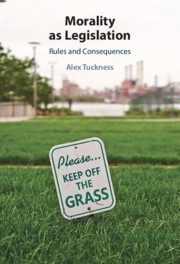Book contents
- Morality as Legislation
- Morality as Legislation
- Copyright page
- Dedication
- Contents
- Acknowledgments
- Abbreviations with Method of Citation
- Introduction
- Part I The Emergence of the Rule-Consequentialist Paradox
- Part II Contemporary Approaches to the Rule-Consequentialist Paradox
- Chapter 6 Four Contemporary Options for Resolving the Paradox
- Chapter 7 A Hybrid Defense of the Legislative Perspective
- Works Cited
- Index
Chapter 6 - Four Contemporary Options for Resolving the Paradox
from Part II - Contemporary Approaches to the Rule-Consequentialist Paradox
Published online by Cambridge University Press: 29 July 2021
- Morality as Legislation
- Morality as Legislation
- Copyright page
- Dedication
- Contents
- Acknowledgments
- Abbreviations with Method of Citation
- Introduction
- Part I The Emergence of the Rule-Consequentialist Paradox
- Part II Contemporary Approaches to the Rule-Consequentialist Paradox
- Chapter 6 Four Contemporary Options for Resolving the Paradox
- Chapter 7 A Hybrid Defense of the Legislative Perspective
- Works Cited
- Index
Summary
Chapter 6 looks at three prominent consequentialist strategies that have been employed more recently to justify different forms of the legislative perspective as well as a fourth option that is Kantian. The first option, exemplified by Robert Goodin, Conrad Johnson, and Frederick Schauer, is to restrict legislative consequentialism’s scope to the design of rules, policies, and institutions. The second option, pursued by Katarzyna de Lazari-Radek and Peter Singer, is to follow Sidgwick and accept a disjunction between moral rules and moral right (or between decision rules and the standard of right). The third option, used by Brad Hooker, seeks to justify a consequentialist legislative perspective based on its fit with our moral judgments using something akin to a reflective equilibrium approach rather than having consequentialism itself be the foundation. The chapter then considers a very different fourth option where the shift to a legislative point of view depends on Kantian claims as seen in the work of Thomas Hill, Jr. and Derek Parfit. Each of these approaches, however, includes serious drawbacks.
- Type
- Chapter
- Information
- Morality as LegislationRules and Consequences, pp. 159 - 189Publisher: Cambridge University PressPrint publication year: 2021



